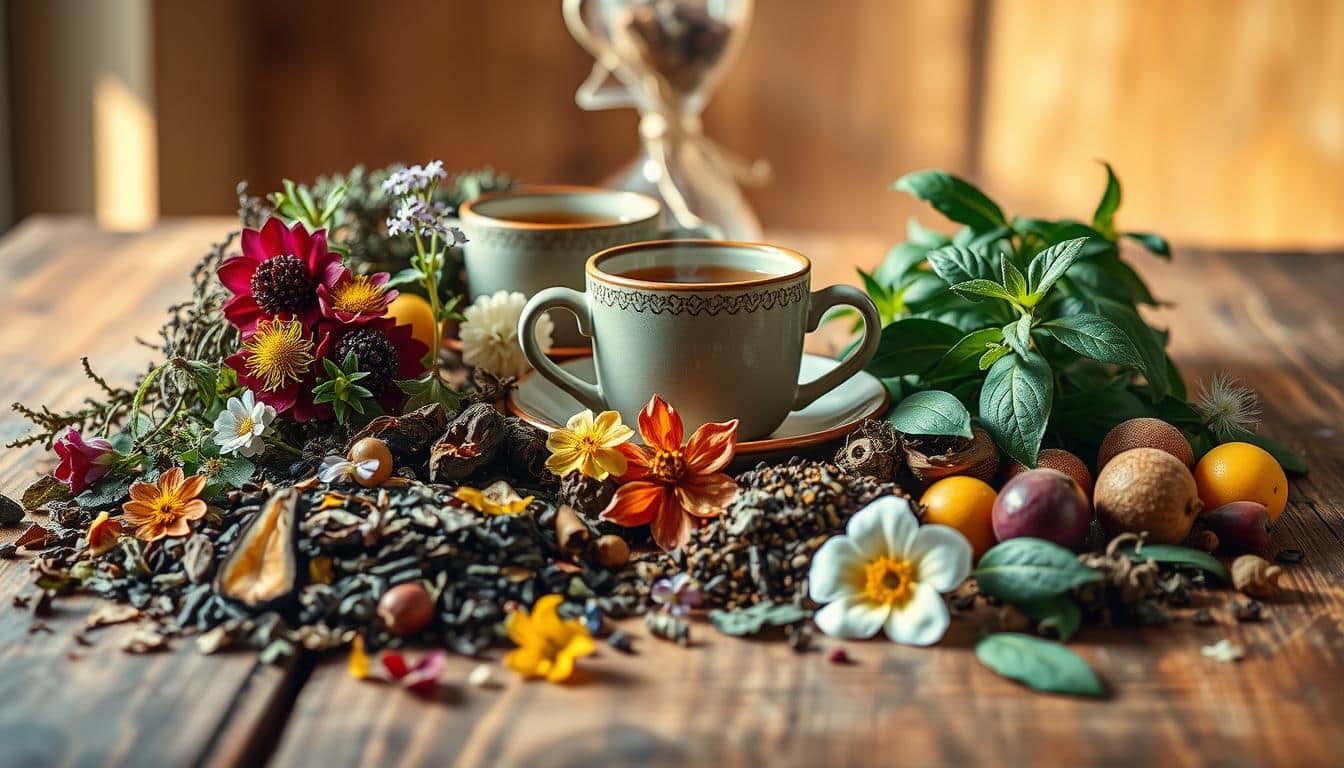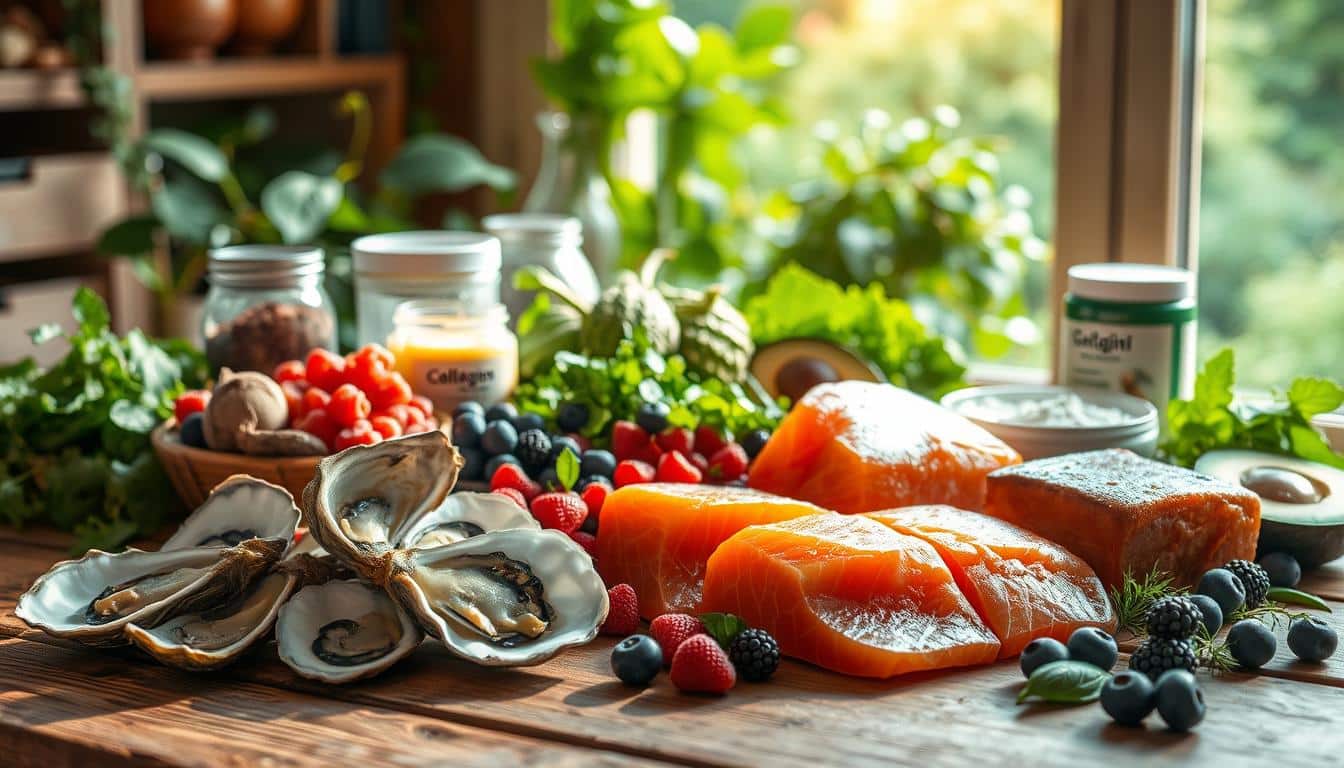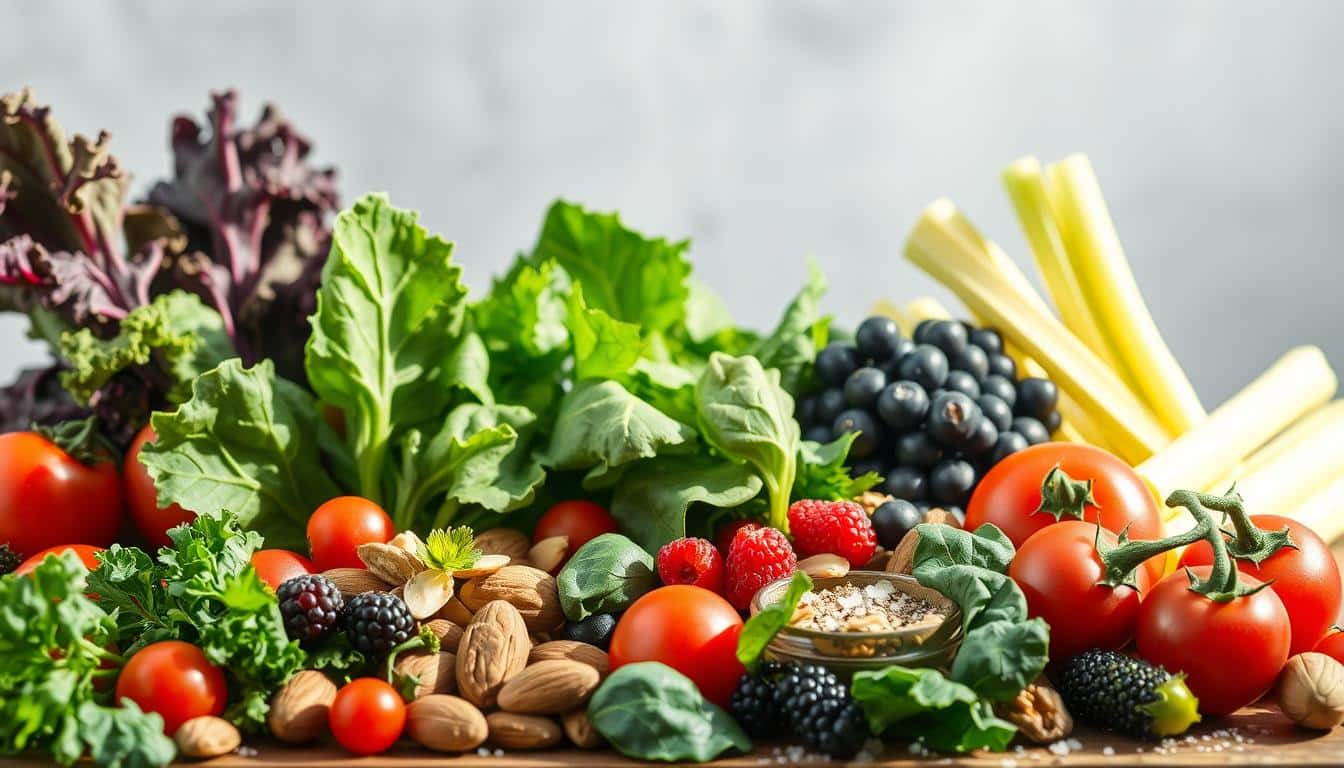Anúncios
Do you want to discover the solution for high blood pressure?
This article offers a practical, evidence-informed Tea Recipe for High Blood Pressure designed for adults in the United States who want complementary, diet-based approaches to support blood pressure control. You will find a soothing blood pressure tea recipe that uses well-studied ingredients, safety notes, and sourcing tips to help you make informed choices alongside your medical care.
Anúncios
We aim to be friendly, clear, and evidence-aware. This content explains how ingredients such as hibiscus may help, covers precautions for people on medication, and shows how to integrate the tea into a broader plan for hypertension. This is complementary advice, not a replacement for prescription therapy; consult your clinician before changing medications or treatments.
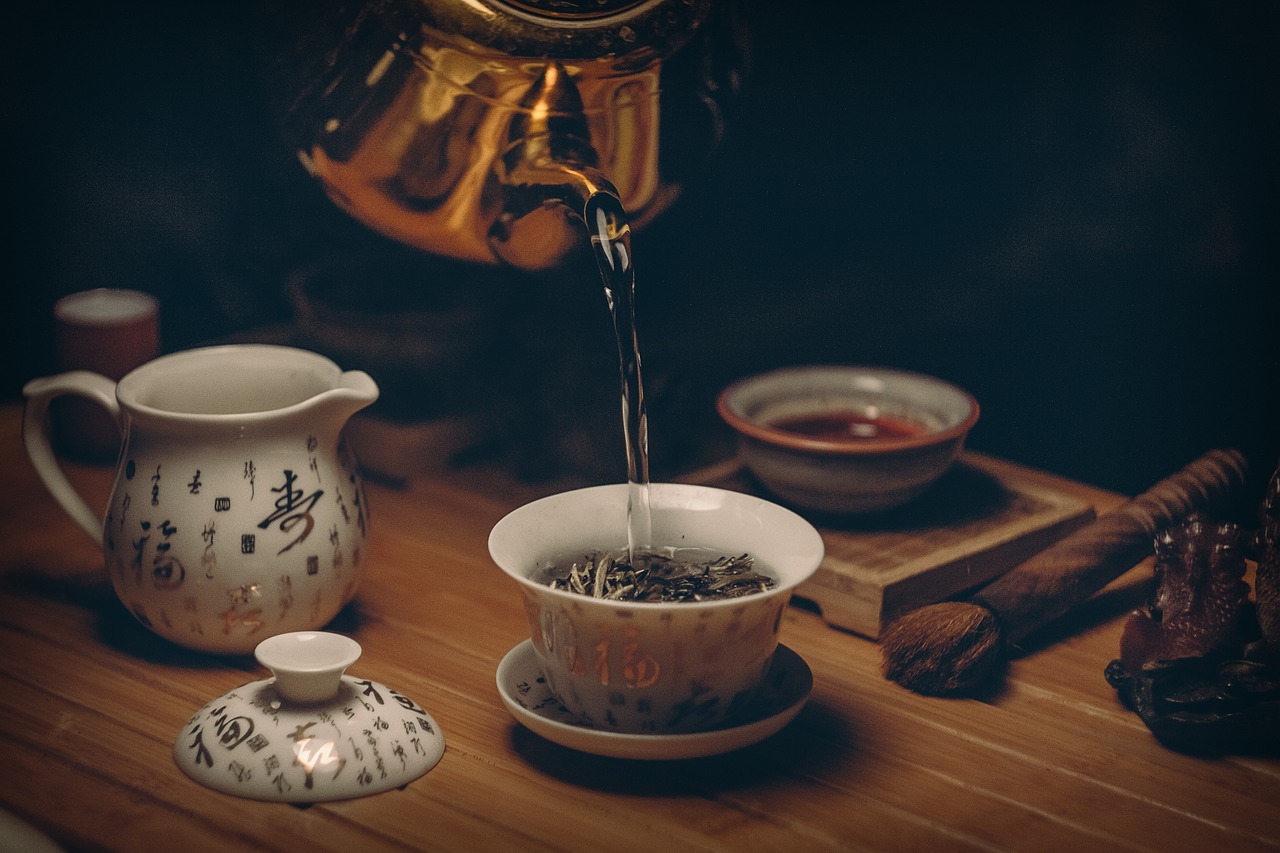
Hibiscus Tea
The article includes practical elements: an easy-to-follow hypertension tea recipe, ingredient explanations, research summaries, and guidance on frequency and portion sizes. You will also get tips on choosing quality brands, spotting interactions, and tracking blood pressure responses over time.
Anúncios
For quick navigation: Section 2 explains hypertension and natural approaches; Section 3 reviews the health benefits of soothing teas; Section 4 gives the recipe and brewing steps; Sections 5–7 detail key herbs, sourcing, and safety; Sections 8–9 cover integration and troubleshooting; Section 10 wraps up with final guidance.
Key Takeaways
- This guide provides a clear hypertension tea recipe and background on how ingredients may help.
- Hibiscus tea for blood pressure is included and discussed with research-based context.
- Safety notes and medication interactions are emphasized—consult a healthcare provider first.
- Practical sourcing tips and brand-aware guidance help you choose quality ingredients.
- The recipe is meant to complement, not replace, prescribed hypertension care.
Understanding High Blood Pressure and Natural Approaches
High blood pressure ranks among the most common chronic conditions in the United States. Clinicians measure blood pressure with two numbers: systolic over diastolic. The American Heart Association uses thresholds such as normal, elevated, stage 1, and stage 2 to guide care. Uncontrolled hypertension raises the chance of heart attack, stroke, and kidney disease. The CDC reports roughly half of U.S. adults have high blood pressure or take medication for it.
What is high blood pressure (hypertension)?
Hypertension refers to persistently elevated arterial pressure that forces the heart and vessels to work harder. Systolic pressure reflects the force during a heartbeat. Diastolic measures pressure between beats. Clinical categories help doctors decide when lifestyle change, monitoring, or drug therapy are needed. Knowing what is hypertension helps people recognize risk and seek timely care.
Why complementary dietary approaches matter
Diet strongly influences blood pressure. Sodium intake and potassium balance shape vascular tone and fluid status. Patterned diets like DASH lower average blood pressure and support weight control. Complementary options such as certain teas, herbs, and targeted food changes can help with natural blood pressure management when used alongside medical advice.
Such approaches are often accessible and low-cost. They can support better adherence to heart-healthy routines, reduce stress, and improve sleep—factors that affect blood pressure. These methods should not replace prescribed medicines for most people. Patients taking antihypertensives should consult a clinician before changing treatment.
Evidence behind herbal and dietary interventions
Clinical trials and reviews provide mixed but promising data. Randomized studies show hibiscus tea can lower systolic and diastolic readings modestly. Trials on hawthorn point to supportive effects on heart function and mild blood pressure changes. Green tea has shown small benefits for vascular function in some research. Rooibos offers antioxidant benefits, though direct blood pressure data remain limited.
Quality of evidence varies by study size, dose, and duration. Short-term trials and different herb preparations limit broad conclusions. Readers seeking deeper review can consult sources such as the American Heart Association and peer-reviewed summaries on PubMed and Cochrane. This helps weigh the evidence for herbs in hypertension against standard care.
| Intervention | Reported Effect on BP | Strength of Evidence | Notes |
|---|---|---|---|
| Hibiscus tea | Modest systolic and diastolic reduction | Moderate (multiple RCTs) | Effective doses varied; typically brewed tea 1–3 cups daily |
| Hawthorn extract | Mild BP support; improves heart symptoms | Low to moderate | Used as adjunctive heart support; monitor with cardiology guidance |
| Green tea | Small improvements in vascular function and BP | Low to moderate | Caffeine content may affect some individuals; choose decaf if needed |
| Rooibos | Antioxidant benefits; limited direct BP data | Low | May support general cardiovascular health; more trials needed |
| DASH-style diet | Significant BP reduction in many trials | High | Emphasizes fruits, vegetables, low-fat dairy, and reduced sodium |
Health Benefits of Soothing Teas for Blood Pressure
Soothing teas can support heart health through several biological pathways. Regular sipping may influence vascular tone, inflammation, oxidative stress, and the nervous system. Small, daily habits that combine calming ritual with active plant compounds offer practical benefits for many people managing blood pressure.
How certain herbs can affect vascular health
Some plants act on the vessels themselves. Hibiscus contains anthocyanins that promote vasodilation by boosting nitric oxide signaling. Hawthorn delivers flavonoids and oligomeric procyanidins that improve coronary and peripheral circulation and may have mild ACE-inhibition-like effects. Other botanicals can alter calcium-channel activity or offer gentle diuretic action to reduce circulating volume and ease pressure on arterial walls.
Antioxidant and anti-inflammatory properties
Oxidative stress and inflammation damage the endothelium and contribute to long-term hypertension. Ingredients such as hibiscus, green tea catechins, and rooibos polyphenols are rich in antioxidants and may blunt that damage. Clinical and preclinical studies suggest these compounds can lower markers of oxidative stress and reduce inflammatory signaling.
Anti-inflammatory herbs such as chamomile and lemon balm can help reduce systemic inflammation when used in supportive blends. The antioxidant effects tend to produce modest blood pressure improvements while improving the overall cardiovascular risk profile.
Potential impacts on stress and sleep that influence blood pressure
Chronic stress and poor sleep raise sympathetic tone and cortisol, which push blood pressure higher. A stress reduction tea ritual can lower heart rate and calm the nervous system. Hawthorn has mild anxiolytic properties that help some people feel more relaxed. Rooibos is naturally caffeine-free and often used at night to avoid stimulation.
Blends that include chamomile or lemon balm can promote better sleep, a key factor in controlling sleep and hypertension links. Beyond compounds, the act of preparing and sipping tea creates a mindful pause that reduces stress and supports healthier blood pressure over time.
| Herb or Ingredient | Main Mechanism | Notable Benefit |
|---|---|---|
| Hibiscus | Vasodilation via nitric oxide; anthocyanin antioxidant | May lower systolic blood pressure and protect vessels |
| Hawthorn | Flavonoids improve circulation; mild ACE-like effects | Supports coronary and peripheral blood flow; calming |
| Green tea | Catechins with antioxidant action; modest vasodilatory effects | Reduces oxidative stress linked to hypertension risk |
| Rooibos | Polyphenols, caffeine-free profile | Calming bedtime option that supports sleep and recovery |
| Chamomile / Lemon balm | GABAergic and mild sedative effects | Improves relaxation and sleep quality, aiding BP control |
Tea Recipe for High Blood Pressure
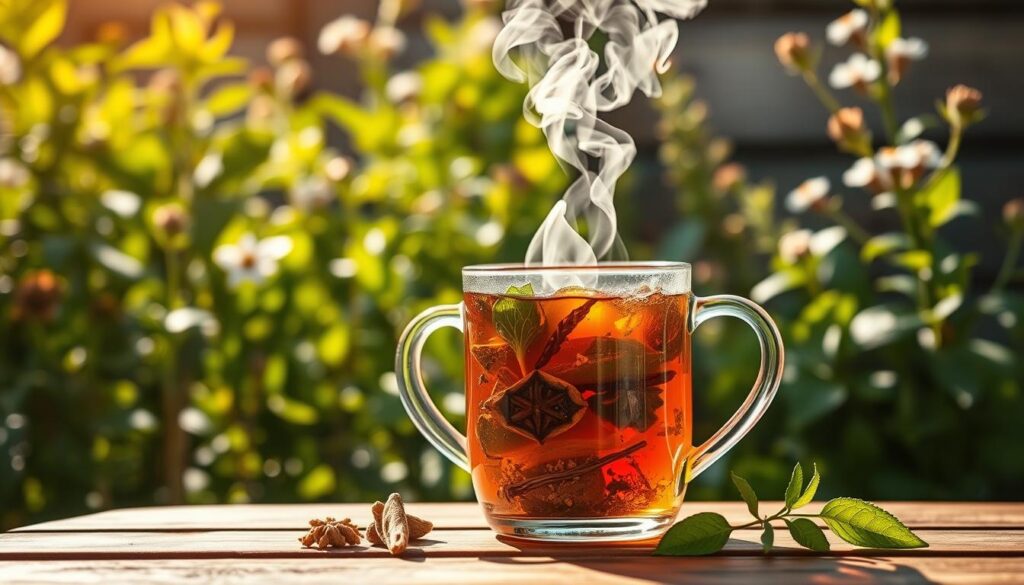
This easy hibiscus hawthorn tea recipe yields about 4 cups (1 L). It balances tart hibiscus with heart-supportive hawthorn and options for caffeine or caffeine-free blends. Read the ingredients, follow the steps, then try variations to match taste and potency.
Ingredients (yields ~4 cups / 1 L)
- 2 tablespoons dried hibiscus petals (Hibiscus sabdariffa) — ~6–8 g
- 1 tablespoon dried hawthorn berries or 2 teaspoons hawthorn leaf/flower blend (Crataegus spp.) — ~3–4 g
- 1 teaspoon green tea leaves (optional for mild caffeine) OR 1 tablespoon rooibos for caffeine-free — ~2–4 g
- 1 teaspoon dried rosehip (optional) — ~2–3 g
- 1–2 slices fresh ginger (optional)
- Sweetener alternatives: stevia, monk fruit, or 1 teaspoon honey (if tolerated)
- Fresh lemon or a splash (½ cup optional when making fruit-forward iced tea)
Metric note: 1 tablespoon ≈ 3–4 g of dried herb depending on density.
Step-by-step brewing instructions
- Bring 4 cups (1 L) of fresh water to a near-boil (about 200°F / 93°C). If using green tea, let water cool 1–2 minutes to ~175–185°F to avoid bitterness.
- Add hibiscus petals, hawthorn, rooibos or green tea (see timing note), rosehip, and ginger to a heatproof teapot or saucepan.
- Pour hot water over the herbs, cover, and steep 8–12 minutes for full extraction.
- If using green tea, use a two-stage brew: steep hibiscus and hawthorn for 8–10 minutes, strain, then add green tea to the hot liquid and steep 2–3 minutes.
- Strain into cups. Sweeten lightly if needed. Serve hot or chill and serve over ice.
- Store leftover brewed tea in the refrigerator up to 48 hours. Reheat gently; do not boil repeatedly.
Variations for taste and potency
- Stronger brew: increase hibiscus to 3 tablespoons and steep up to 12 minutes. Monitor blood pressure and adjust frequency.
- Caffeine-free: replace green tea with extra rooibos or lemon balm for a soothing cup.
- Fruit-forward iced tea: add ½ cup unsweetened pomegranate juice or muddled berries while chilling for extra polyphenols.
- Lighter daily brew: halve all herb quantities for a milder flavor suitable for more frequent consumption.
This hibiscus hawthorn tea recipe highlights blood pressure tea ingredients and gives clear guidance on how to brew hibiscus tea for best flavor and extraction. Start with milder versions if you take antihypertensive medications and track responses closely.
Key Herbs and Ingredients Explained
Below is a focused guide to the main herbs in the soothing tea blend. Read each short entry to learn uses, typical doses, and safety notes you can discuss with your clinician.
Hibiscus has strong clinical support for modest blood pressure effects. Multiple randomized trials and meta-analyses show hibiscus tea, often brewed from 1–3 g dried calyces per cup, taken as 1–2 cups daily, can lower systolic pressure by several mmHg in people with hypertension or prehypertension.
Proposed mechanisms include vasodilation, ACE-like inhibition, mild diuresis, and high anthocyanin content. Typical dosage guidance in trials centers on about 1–3 grams per cup or 2 cups daily. Because hibiscus can add to drug effects, avoid high intake without medical advice, and discuss use during pregnancy.
Hawthorn is used for supportive cardiac care and symptom relief in mild chronic heart failure. Standardized extracts rich in flavonoids and procyanidins have shown improved exercise tolerance and quality of life in some trials.
Clinical trial doses often use standard extracts, for example 250–500 mg twice daily, not raw berry measures. Note that hawthorn safety concerns include interactions with cardiac drugs such as beta-blockers, digoxin, and calcium channel blockers. It may potentiate hypotension. Consult a cardiologist or pharmacist before adding hawthorn to a regimen that includes prescription heart medicines.
Green tea delivers catechins like EGCG plus modest caffeine. Regular consumption or standardized extracts associate with small reductions in blood pressure and improved endothelial function in some studies.
For people sensitive to stimulants, caffeine can raise blood pressure. Consider decaffeinated green tea or limiting intake if you notice jitteriness or rises in readings. Use green tea as a daytime component when a gentle stimulant is acceptable for energy and metabolic support.
Rooibos is naturally caffeine-free. Its key polyphenols, such as aspalathin and nothofagin, provide antioxidant and anti-inflammatory effects that support vascular health in theory.
Human trials on rooibos blood pressure are limited. The herb makes a good evening base or a caffeine-free option for people who need to avoid stimulants. Use rooibos regularly for antioxidant support, and pair it with other active herbs when clinically appropriate.
| Herb | Common Active Compounds | Typical Study Dose | Notes on Use and Safety |
|---|---|---|---|
| Hibiscus | Anthocyanins, organic acids | 1–3 g dried calyces per cup; many trials used 1–2 cups/day | Can lower systolic BP; may interact with antihypertensives and affect estrogenic pathways. Avoid high intake in pregnancy without approval. |
| Hawthorn | Flavonoids, procyanidins | Standardized extract 250–500 mg twice daily (extracts vary) | Supports heart failure symptoms; may interact with beta-blockers, digoxin, and calcium channel blockers. Consult specialist. |
| Green Tea | Catechins (EGCG), caffeine | Typical beverage servings; extract doses vary by product | May gently lower BP and improve endothelial function; caffeine can raise BP in sensitive individuals—use decaffeinated if needed. |
| Rooibos | Aspalathin, nothofagin, polyphenols | Brewing as tea daily; standardized doses not well established | Good caffeine-free option for evening use; limited direct human BP studies but promising antioxidant profile. |
How to Choose Quality Ingredients and Tea Brands
Picking the right herbs and brands matters for flavor and safety. Look for clear labeling, origin details, and simple ingredient lists when you shop for hibiscus, rooibos, or hawthorn. A short checklist helps you compare options quickly.
Organic vs. conventional herbs
Choose organic herbs for tea when you want fewer pesticide residues and greater environmental assurance. USDA Organic labeling signals that a product met strict standards in the U.S.
Conventional herbs can still be safe if the supplier runs tests and follows good manufacturing practices. If budget is a concern, prioritize organic for herbs known to carry higher residues, such as leaves and delicate petals.
Recognizing high-quality loose-leaf and bagged teas
To choose quality loose-leaf tea, look for whole or large pieces rather than fine dust. High-grade hibiscus shows vibrant red petals and a floral scent. Rooibos should appear reddish-brown and free from excessive stems.
Pyramid sachets and whole-leaf tea bags often give better infusion than standard paper bags. Check ingredient lists to avoid added fillers, flavorings, or sugars that mask true herb quality.
Packaging matters. Airtight, opaque containers slow oxidation. Avoid products with long exposure to light or clear plastic windows for long storage life. Freshness dates or harvest years are useful for gauging peak flavor.
Safe sourcing tips and certifications to look for
Prefer brands that share origin details: hibiscus commonly comes from Egypt, Sudan, or Mexico while rooibos comes from South Africa. Suppliers that list country of origin tend to be more transparent about sourcing.
Look for tea certifications USDA organic, Non-GMO, NSF when available. The Non-GMO Project Verified mark and third-party testing by NSF or ConsumerLab add confidence about contaminants and label accuracy.
Fair Trade and Rainforest Alliance seals help when ethical sourcing is important. Brands such as Traditional Medicinals, Numi, Rishi, Pukka, and Davidson’s often publish testing results and sourcing notes you can review before buying.
| Consideration | What to look for | Why it matters |
|---|---|---|
| Label transparency | Country of origin, ingredient list, packed/harvest date | Shows supplier honesty, helps assess freshness and risk |
| Form | Whole petals/leaves, minimal dust, pyramid sachets | Yields fuller flavor and stronger, cleaner brews |
| Packaging | Airtight, opaque containers with resealable seals | Protects flavor and potency during storage |
| Certifications | tea certifications USDA organic, Non-GMO, NSF, Fair Trade | Confirms production standards, reduced contaminants, ethical sourcing |
| Testing and safety | Third-party lab results, heavy metal and microbial testing | Essential for vulnerable groups and for peace of mind |
| Brand reputation | Known companies with published sourcing—Rishi, Numi, Traditional Medicinals | Often offers consistent quality and accessible customer support |
Safety Considerations and Interactions
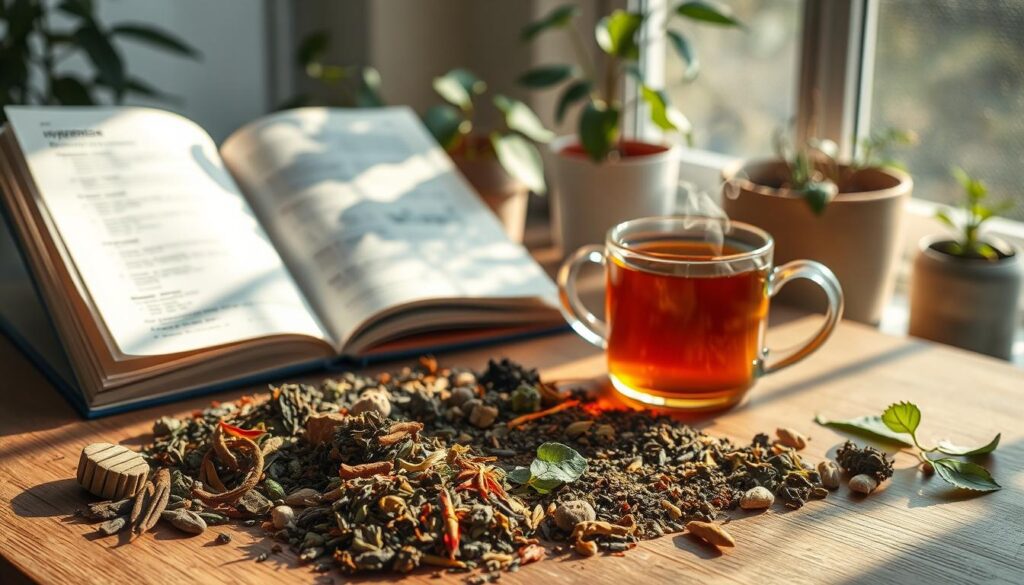
Before adding any soothing tea to your routine, review potential risks and drug interactions. Small doses can help some people, while the same blend may be unsafe for others. Read labels and keep a log of herbs and medications to share with your clinician.
Common medication interactions to watch for
Hibiscus and hawthorn can lower blood pressure and may amplify prescription antihypertensives like lisinopril, losartan, amlodipine, or metoprolol. Watch for lightheadedness, fainting, or unusually low readings.
Hawthorn interactions with cardiac drugs deserve special care. It can influence digoxin effects and alter how some medicines are metabolized. Ask a pharmacist to check for CYP enzyme interactions when you use concentrated extracts or take several drugs.
Combined diuretic effects may change electrolytes. People on furosemide or spironolactone should monitor sodium and potassium. Anticoagulant therapy such as warfarin requires review, since herbs sometimes affect clotting pathways.
Who should avoid or modify this tea
Pregnant and breastfeeding people should avoid hibiscus unless cleared by an obstetrician. Animal studies suggest possible uterine effects, and human safety data are limited.
Anyone on multiple heart or blood pressure medications, or with baseline hypotension, should not start regular herbal tea without medical advice. Those with known herb allergies or on anticoagulants need targeted review.
Recommended consultation with healthcare providers
Discuss your recipe and regular use with your primary care physician or cardiologist. Ask them to document baseline vitals and plan follow-up checks. For complex conditions like heart failure or arrhythmias, seek specialist approval before using hawthorn products.
Request a pharmacist medication review to confirm possible hibiscus drug interactions or hawthorn interactions. Keep a home blood pressure log and report any dizziness, swelling, or palpitations promptly.
| Concern | Potential Effect | Action |
|---|---|---|
| Antihypertensives (ACE inhibitors, ARBs, CCBs, beta-blockers) | Excessive blood-pressure lowering; dizziness, fainting | Start low, monitor BP, consult cardiologist |
| Cardiac glycosides (digoxin) | Altered drug levels; rhythm changes | Avoid concentrated hawthorn extracts without specialist OK |
| Diuretics | Electrolyte shifts; volume changes | Check electrolytes, adjust doses with clinician |
| Anticoagulants (warfarin) | Possible clotting interaction; bleeding risk | Have INR monitored and consult pharmacist |
| CYP-metabolized drugs (various) | Altered metabolism; reduced or increased drug effect | Pharmacist interaction check; consider alternative timing |
If you are unsure when to avoid herbal tea, prioritize safety and consult doctor for herbal interactions before making it part of a daily plan.
Incorporating the Tea into a Blood Pressure Management Plan
Adding a soothing tea to your routine can be part of a practical blood pressure lifestyle plan when done thoughtfully. Start with a clear approach, set small goals, and keep records so you and your clinician can see any patterns.
Recommended frequency and portion sizes
Begin with 1 cup (8–12 ounces) daily of the standard recipe to assess tolerance and response. Many clinical reports use 1–2 cups; some people have up to 3 cups, but stronger brews should be taken less often.
Freshly brewed tea is best. Refrigerate leftovers and use within 48 hours. People on prescription blood pressure medications should start low and monitor closely.
Complementary lifestyle changes: diet, exercise, sleep
Pair tea use with a DASH-style diet: lower sodium, eat more potassium-rich foods like bananas, spinach, and potatoes, favor whole grains and lean protein, and load up on vegetables.
Aim for 150 minutes per week of moderate aerobic activity such as brisk walking or cycling, with strength training twice weekly as tolerated. Losing 5–10 pounds often yields a measurable blood pressure benefit.
Prioritize 7–9 hours of sleep nightly and use the tea ritual as a calming break. Try deep breathing or short guided meditations to reduce stress. Limit alcohol and avoid tobacco to support your goals.
Tracking effects: how to monitor blood pressure responses
Use a validated upper-arm automatic monitor from brands like Omron or A&D Medical to track changes. Calibrate at a clinic when possible.
Establish a baseline by taking readings twice daily, morning and evening, for 7 days before you start the tea. Continue twice-daily readings for several weeks while noting tea intake and any symptoms.
| What to Record | Why It Matters |
|---|---|
| Date and time of reading | Shows trends and timing effects related to tea consumption |
| Supine or seated position | Ensures consistent, comparable measurements |
| Tea dose and time taken | Links any blood pressure change to how often to drink hibiscus tea or to tea for hypertension daily use |
| Symptoms (lightheadedness, dizziness) | Helps detect excessive drops or adverse reactions |
| Medication timing | Identifies potential interactions with antihypertensive drugs |
Look for consistent shifts in systolic or diastolic values and any episodes of lightheadedness. If systolic readings fall below 90 mmHg with symptoms, seek immediate medical help. Share your log with your clinician so they can adjust medications or advise on how often to drink hibiscus tea within your individual plan.
To learn how the tea fits long term, keep notes and revisit your data every few weeks. Use the tracking process to refine when you drink tea, whether you treat it as tea for hypertension daily habit, and how it complements your wider blood pressure lifestyle plan.
Troubleshooting and Frequently Experienced Variations
Small tweaks often fix common issues with herbal blends for blood pressure support. Use gentle changes first and test one at a time. Below are practical fixes for taste, digestion, and caffeine sensitivity that keep the recipe effective and safe.
Adjusting flavor without adding sodium or sugar
Bring brightness with fresh lemon or lime zest. A splash of unsweetened cranberry or pomegranate juice lifts flavor without extra table salt. Fresh mint leaves and a cinnamon stick add aroma and warmth.
To reduce sugar in tea try stevia or monk fruit in small amounts. If you prefer a tiny bit of honey, use a teaspoon and stir well. Mix in rooibos or a few apple slices to mellow hibiscus tartness.
Dealing with side effects like digestive upset
Mild stomach upset or increased urination can happen, especially when first trying new herbs. Cut steep time or lower the herb amount to see if symptoms ease.
Add a slice of fresh ginger to soothe the stomach. Drink the tea with food rather than on an empty stomach. If symptoms persist, stop the tea and speak with a healthcare provider about hibiscus tea side effects.
Adapting the recipe for caffeine sensitivity
Remove green tea and use rooibos or extra hibiscus as the base to create caffeine-free tea alternatives. Choose decaffeinated green tea if you want gentle daytime benefits.
If you notice palpitations, sleep trouble, or anxiety, switch to fully caffeine-free blends and avoid late-afternoon servings. These steps help preserve sleep while keeping the blend heart-friendly.
Try one change at a time and note results in a simple log. Small, measured edits often solve flavor and tolerance issues without losing the recipe’s benefits.
Conclusion
The soothing tea for hypertension described here — a blend centered on hibiscus and hawthorn with optional green tea or rooibos — offers a calm, evidence-informed complement to usual care. This hibiscus hawthorn tea summary highlights modest blood pressure benefits, antioxidant and mild vasodilatory effects, and a relaxing ritual that can support other natural ways to lower blood pressure.
Safety matters: use the recipe alongside lifestyle measures like the DASH diet, regular exercise, and good sleep. People on antihypertensives or with cardiac conditions should consult a clinician or pharmacist before regular use. When used appropriately, the tea can integrate into hypertension care as a gentle, supportive step rather than a replacement for prescribed treatment.
Practical next steps: try the milder version first, choose high-quality organic ingredients when possible, and monitor blood pressure at home for changes. If readings shift meaningfully or you notice symptoms, report back to your healthcare team. View this drink as part of a daily routine that promotes relaxation and heart health while you continue evidence-based care.
